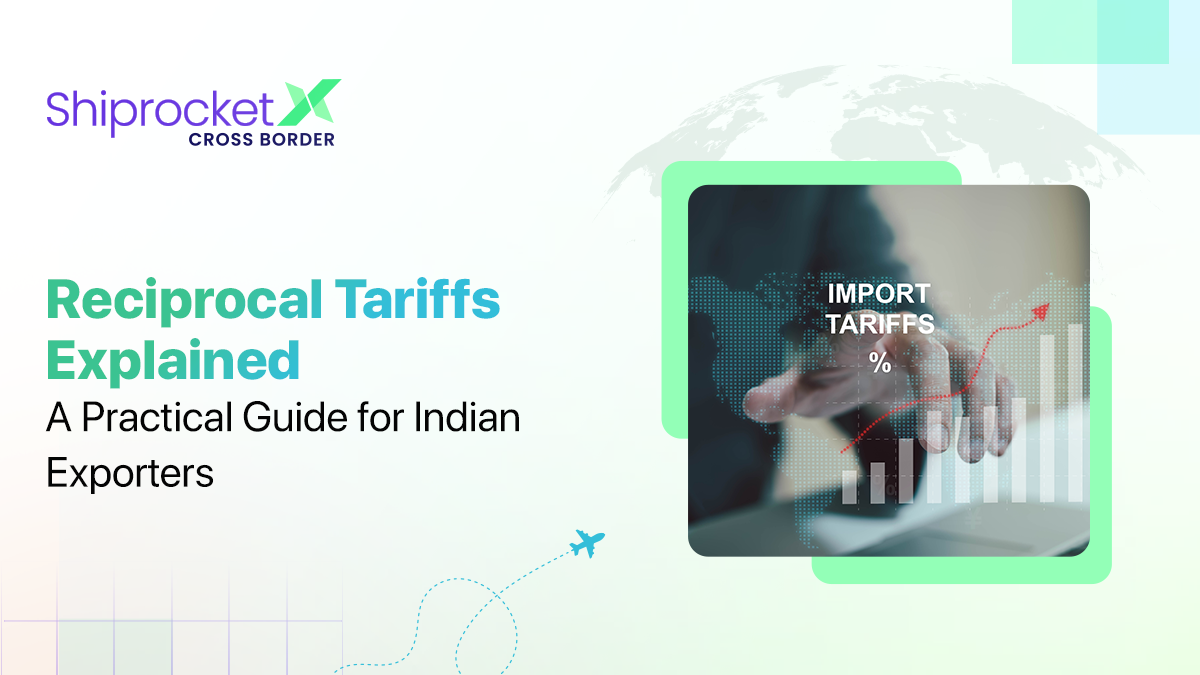FIRC: What It Is & Why Exporters Need This Document
- Defining the Foreign Inward Remittance Certificate
- Why FIRC Plays a Crucial Role in Global Business Transactions?
- Breaking Down the Data on an FIRC Document
- Which Authorities Provide FIRCs?
- Common Situations That Require an FIRC
- Step-by-Step Guide to Getting a FIRC from Your Bank
- Is it Possible to Avoid a FIRC?
- Why ShiprocketX is the Go-to Solution for Cross-Border Trade
- Conclusion
Global trade brings along immense opportunities, but it also requires exporters to meet many types of regulatory obligations. FIRC (Foreign Inward Remittance Certificate) is among the most important documents that confirm receipt of payments from cross-border buyers.
India exported goods worth over $776.68 billion in FY 2023–24, as shown in the Ministry of Commerce’s provisional data. That’s a massive volume of cross-border payments that must be properly documented. FIRC is mostly the only official proof accepted by Indian authorities to confirm that an international payment has been received into an Indian bank account.
Having your paperwork sorted is a necessity whether you’re exporting handcrafted goods, IT services, or large-scale manufacturing products, and FIRC tops that list. This article talks all about this certificate in detail, what it is, and why you need it for your business.

Defining the Foreign Inward Remittance Certificate
A Foreign Inward Remittance Certificate is issued by banks in India as evidence that an individual or business has received funds from abroad. It is usually necessary when the purpose of the transfer relates to trade in goods and services.
Simply put, FIRC shows that you, as an Indian entity, have legitimately earned income from overseas. The details that this document includes are:
- Amount received
- Currency
- Sender’s name and country
- Reason for the transaction
Why FIRC Plays a Crucial Role in Global Business Transactions?
FIRCs serve a bunch of practical functions for Indian exporters. They are more than just routine paperwork, with customs officials, auditors, export promotion councils, and tax authorities often asking for this certificate.
The reasons it matters are:
Export Incentives
There are many government export benefits that you get only after submitting a FIRC as proof of foreign currency earnings. One such example is the RoDTEP (Remission of Duties and Taxes on Exported Products) scheme, which refunds embedded taxes and duties that are not reimbursed through other mechanisms. You have to show valid shipping documents along with the FIRC to confirm receipt of payment in foreign currency to claim this benefit.
GST Refunds
FIRC is one of the most important documents for service exporters to claim GST refunds. That’s because under GST law, exports of services are treated as zero-rated supplies, which means no GST is charged, but the exporter can still file for a refund on the input tax credit (ITC) they’ve paid on business expenses.
To prove that a service was exported and paid for in foreign currency, authorities need to see the FIRC along with the invoice as supporting evidence. Without the FIRC, the refund application is mostly considered incomplete.
Income Tax Records
FIRCs also help validate overseas earnings, reducing the likelihood of queries or penalties, during audits. When a business or individual receives international payments, especially in large sums or regularly, the Income Tax Department may ask for evidence that these are legitimate export receipts and not unexplained income.
A FIRC acts like bank-certified evidence proving that the funds were received for a genuine commercial purpose, such as the export of goods or services. This adds credibility to your income declarations and helps avoid disputes, notices, or tax scrutiny related to foreign earnings.
Foreign Exchange Compliance
FIRCs support compliance with Reserve Bank of India (RBI) guidelines, making sure all foreign funds are correctly tracked. Missing FIRCs could mean losing out on benefits, delaying your claims, or triggering compliance issues down the line.
Breaking Down the Data on an FIRC Document
A FIRC contains a standard set of data points. Knowing what each part means helps you check its accuracy and respond to any queries from authorities.
What you’ll usually find:
- FIRC Number: A unique reference code.
- Beneficiary’s Name and Address: Your company or personal name and registered address.
- Foreign Currency Details: Amount received, currency type, and equivalent in INR.
- Purpose Code: A code defined by RBI that indicates why the money was received (e.g., export of goods, software services, etc.).
- Sender Information: Name and address of the remitter.
- Date of Credit: When the money was deposited into your account.
- IFSC and Bank Branch: Details of the bank that processed the payment.
Double-check this information to avoid any discrepancies that might delay government clearances or audits.
Which Authorities Provide FIRCs?
FIRCs are typically issued by Authorised Dealer (AD) banks, which are banks authorised by the RBI (Reserve Bank of India) to take up foreign exchange matters. Not all bank branches are ADs, so it’s important to work with a branch that is permitted to process foreign currency inflows.
Most private and public sector banks offer FIRCs digitally now, replacing the older physical format. These are often issued as e-FIRCs, which are secure PDF documents with a digital signature.
Note that from 2016 onwards, the RBI has encouraged banks to provide e-FIRCs directly to the Export Data Processing and Monitoring System (EDPMS), helping to automate some parts of the compliance process.
Common Situations That Require an FIRC
Not every international transfer needs an FIRC, but many do, especially if funds are tied to trade. Here are some common use cases:
Export of Goods: Most physical exports require FIRC submission to claim incentives under schemes like RoDTEP or RoSCTL.
Export of Services: IT, consulting, and creative professionals receiving payments from abroad need FIRCs for tax and compliance purposes.
Foreign Direct Investment (FDI): When a foreign investor invests in an Indian company, FIRCs are used for company registration and compliance.
eCommerce Exports: Sellers on platforms like Etsy or Amazon Global often use payment gateways that deposit funds from abroad. Even in such cases, FIRCs are needed for GST or incentives.
Royalty or Licence Fees: Payments for intellectual property, music rights, or software licences often require FIRC documentation.
Step-by-Step Guide to Getting a FIRC from Your Bank
Here is a general overview of the process to get your FIRC:
1. Receive the Payment: Make sure the purpose of the transfer is clearly stated by the sender. For exports, the invoice and purpose code must align.
2. Inform Your Bank: Submit a request for FIRC once the funds are credited. Some banks provide online portals or email-based request systems.
3. Provide Supporting Documents:
- Copy of invoice or agreement
- Shipping Bill (for goods)
- PAN and IEC (Importer Exporter Code)
- Purpose Code
4. FIRC Issuance: The bank verifies the remittance details and issues the FIRC, often within a few working days.
5. Download or Receive by Email: Most banks now send digital FIRCs directly or allow download via net banking.
If you follow up timely, you’re likely to avoid any delays, especially if your incentives or tax filings are time-sensitive.
Is it Possible to Avoid a FIRC?
In some low-value transactions or non-trade remittances (like personal gifts or family transfers), banks may not issue an FIRC. However, for business payments, specifically those involving exports or services, this document is usually compulsory.
Skipping the FIRC process can cause issues:
- Loss of export benefits or delays in reimbursements
- Problems in GST compliance
- Audit flags for overseas income
Some exporters mistakenly assume that a Foreign Inward Remittance Advice (FIRA) or SWIFT copy is sufficient, but these don’t carry the same legal standing as a FIRC.
Why ShiprocketX is the Go-to Solution for Cross-Border Trade
It often feels pretty slow, fragmented, and costly when receiving payments from international buyers. ShiprocketX, a cross-border shipping and remittance service, makes the process quick and hassle-free for eCommerce sellers and SMEs.
What we do to make this possible:
- We integrate shipping and payments, so you receive payments in INR with full transparency, without the need to manage multiple platforms.
- Our AI-powered platform automatically generates FIRCs for all cross-border payments, alleviating the need for bank follow-up.
- Foreign payments are processed quickly and remitted directly to Indian bank accounts.
- We offer GST-ready documents, so exporters have the right paperwork to back up tax returns and filings.
Conclusion
Getting paid for exports is one part of the job. Having the right documentation to support those payments is another. The Foreign Inward Remittance Certificate is a small but important piece of that puzzle for Indian exporters.
FIRC helps bridge your international payments with local compliance, supporting your claims, protecting your incentives, and keeping your books in order. Regardless of the type of goods you’re transporting, this export document is necessary for most of the financial discussions between you and your bank, auditor, and authorities.





